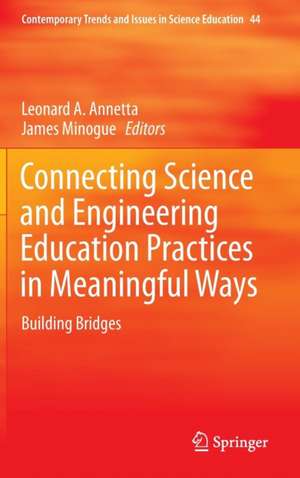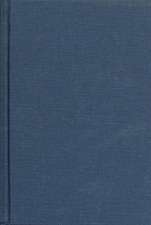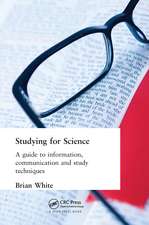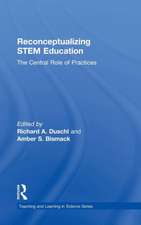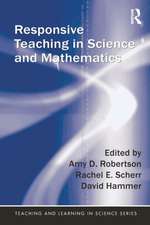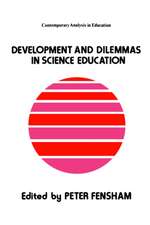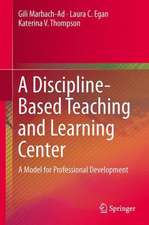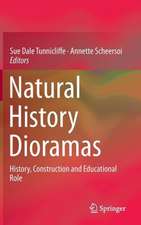Connecting Science and Engineering Education Practices in Meaningful Ways: Building Bridges: Contemporary Trends and Issues in Science Education, cartea 44
Editat de Leonard A. Annetta, James Minogueen Limba Engleză Hardback – 14 mar 2016
All of the contributing authors consider the same core question: Given the rapidly changing landscape of science education, including the elevated status of engineering design, what are the best approaches to the effective integration of the science and engineering practices? They answered with rich descriptions of pioneering approaches, critical insights, and useful practical examples of how embodying a culture of interdisciplinarity and innovation can fuel the development of a scientifically literate citizenry
. This collection of work builds traversable bridges across diverse research communities and begins to break down long standing disciplinary silos that have historically often hamstrung well-meaning efforts to bring research and practice from science and engineering together in meaningful and lasting ways.
| Toate formatele și edițiile | Preț | Express |
|---|---|---|
| Paperback (1) | 645.47 lei 6-8 săpt. | |
| Springer International Publishing – 24 apr 2018 | 645.47 lei 6-8 săpt. | |
| Hardback (1) | 651.84 lei 6-8 săpt. | |
| Springer International Publishing – 14 mar 2016 | 651.84 lei 6-8 săpt. |
Din seria Contemporary Trends and Issues in Science Education
- 20%
 Preț: 568.91 lei
Preț: 568.91 lei - 20%
 Preț: 814.78 lei
Preț: 814.78 lei - 18%
 Preț: 951.77 lei
Preț: 951.77 lei - 15%
 Preț: 638.43 lei
Preț: 638.43 lei - 15%
 Preț: 636.80 lei
Preț: 636.80 lei - 15%
 Preț: 628.08 lei
Preț: 628.08 lei - 15%
 Preț: 637.46 lei
Preț: 637.46 lei - 18%
 Preț: 951.29 lei
Preț: 951.29 lei - 15%
 Preț: 644.95 lei
Preț: 644.95 lei - 18%
 Preț: 951.91 lei
Preț: 951.91 lei - 18%
 Preț: 1218.66 lei
Preț: 1218.66 lei - 18%
 Preț: 953.65 lei
Preț: 953.65 lei - 15%
 Preț: 641.71 lei
Preț: 641.71 lei - 15%
 Preț: 697.15 lei
Preț: 697.15 lei - 15%
 Preț: 644.18 lei
Preț: 644.18 lei - 15%
 Preț: 640.55 lei
Preț: 640.55 lei - 15%
 Preț: 640.06 lei
Preț: 640.06 lei - 15%
 Preț: 639.08 lei
Preț: 639.08 lei - 18%
 Preț: 1388.68 lei
Preț: 1388.68 lei -
 Preț: 389.31 lei
Preț: 389.31 lei - 15%
 Preț: 465.66 lei
Preț: 465.66 lei - 18%
 Preț: 1832.08 lei
Preț: 1832.08 lei - 15%
 Preț: 641.85 lei
Preț: 641.85 lei -
 Preț: 398.15 lei
Preț: 398.15 lei - 15%
 Preț: 644.18 lei
Preț: 644.18 lei - 18%
 Preț: 945.47 lei
Preț: 945.47 lei - 15%
 Preț: 644.30 lei
Preț: 644.30 lei - 18%
 Preț: 1215.04 lei
Preț: 1215.04 lei
Preț: 651.84 lei
Preț vechi: 766.87 lei
-15% Nou
Puncte Express: 978
Preț estimativ în valută:
124.74€ • 135.45$ • 104.79£
124.74€ • 135.45$ • 104.79£
Carte tipărită la comandă
Livrare economică 22 aprilie-06 mai
Preluare comenzi: 021 569.72.76
Specificații
ISBN-13: 9783319163987
ISBN-10: 3319163981
Pagini: 270
Ilustrații: XI, 385 p. 75 illus.
Dimensiuni: 155 x 235 x 28 mm
Greutate: 0.74 kg
Ediția:1st ed. 2016
Editura: Springer International Publishing
Colecția Springer
Seria Contemporary Trends and Issues in Science Education
Locul publicării:Cham, Switzerland
ISBN-10: 3319163981
Pagini: 270
Ilustrații: XI, 385 p. 75 illus.
Dimensiuni: 155 x 235 x 28 mm
Greutate: 0.74 kg
Ediția:1st ed. 2016
Editura: Springer International Publishing
Colecția Springer
Seria Contemporary Trends and Issues in Science Education
Locul publicării:Cham, Switzerland
Public țintă
ResearchCuprins
Introduction,Len Annetta, George Mason University and James Minogue, North Carolina State University.- Section I: Setting the Stage…The Culture and the Challenges.- Ch.1: Creating Disruptive Innovators: The Technology and Engineering Spectrum, David Nelson and Leonard A. Annetta, George Mason University.- Ch. 2: Grand Challenges for Engineering Education, Cary Sneider, Portland State University.- Section II: Student-Centered Design…Exemplary Projects and Programs that Transfer Theory to Practice.- Ch. 3: Museum Design Experiences That Recognize New Ways to Be Smart, Dorothy Bennett, Peggy Monahan, and Margaret Honey, New York Hall of Science.- Ch. 4: Five Principles for Supporting Design Activity, Catherine N. Langman, Judith Zawojewski, Illinois Institute of Technology; Stephanie Whitney, DePaul University.- Ch. 5: Studio STEM: A Model to Enhance Integrative STEM Literacy Through Engineering Design, Michael A. Evans, North Carolina State University; Christine Schnittka, Auburn University; Brett D. Jones, Virginia Tech; Carol Brandt, Temple University.- Ch. 6: Instrumental STEM (iSTEM): An Integrated STEM Instructional Model, Daniel Dickerson, Diana Cantu, Stephanie Hathcock, William McConnell, Old Dominion University; Doug R. Levin, Washington College.- Ch. 7: Robotics Education done right: Robotics Expansion™, a STEAM based curricula, Anthony J. Nunez, Infamous Robotics, LLC.- Ch. 8: Designing serious educational games (SEGs) for learning biology: Pre-service
teachers’experiences and reflections, Meng-Tzu Cheng, National Changhua University, Ying-Tien Wu, National Central University.- Section III: Preparing Teachers for the Grand Challenges…Exemplary Professional Development Practices.- Ch. 9: Language of Design within Science and Engineering, Nicole Webber & Kristina Lamour Sansone, Lesley University.- Ch. 10: Teaching with Design Thinking: Developing new vision and approaches to 21st Century learning, Shelley Goldman & Molly Zielezinski, Stanford University.- Ch. 11: Elementary School Engineering for Fictional Clients in Children’s Literature, Elissa Milto, Kristen Wendell, Jessica Watkins, David Hammer, Kathleen Spencer, Merredith Portsmore, & Chris Rogers Tufts University Center for Engineering Education and Outreach.- Ch. 12: Teaching Engineering Design in Elementary Science Methods Classes, Christine D. Tippett, University of Ottawa.- Ch. 13: Infusing Engineering Concepts into High School Science: Opportunities & Challenges, Rodney Custer, Black Hills State University; Arthur Eisenkraft, Kristen Wendell University of Massachusetts-Boston; Jenny Daugherty, Purdue University; Julie Ross, University of Maryland-Baltimore County.- Ch. 14: How Do Secondary Level Biology Teachers Make Sense of Using Mathematics in Design-Based Lessons About a Biological Process? Charlie Cox, Penn State University; Birdy Reynolds, Anita Schuchardt & Christian Schunn, University of Pittsburgh.- Ch. 15: Connecting Science and Engineering Practices: Possibilities, Concerns and Issues, Michael Clough & Joanne Olsen, Center for Excellence in Science, Mathematics and Engineering Education, Iowa State University.
teachers’experiences and reflections, Meng-Tzu Cheng, National Changhua University, Ying-Tien Wu, National Central University.- Section III: Preparing Teachers for the Grand Challenges…Exemplary Professional Development Practices.- Ch. 9: Language of Design within Science and Engineering, Nicole Webber & Kristina Lamour Sansone, Lesley University.- Ch. 10: Teaching with Design Thinking: Developing new vision and approaches to 21st Century learning, Shelley Goldman & Molly Zielezinski, Stanford University.- Ch. 11: Elementary School Engineering for Fictional Clients in Children’s Literature, Elissa Milto, Kristen Wendell, Jessica Watkins, David Hammer, Kathleen Spencer, Merredith Portsmore, & Chris Rogers Tufts University Center for Engineering Education and Outreach.- Ch. 12: Teaching Engineering Design in Elementary Science Methods Classes, Christine D. Tippett, University of Ottawa.- Ch. 13: Infusing Engineering Concepts into High School Science: Opportunities & Challenges, Rodney Custer, Black Hills State University; Arthur Eisenkraft, Kristen Wendell University of Massachusetts-Boston; Jenny Daugherty, Purdue University; Julie Ross, University of Maryland-Baltimore County.- Ch. 14: How Do Secondary Level Biology Teachers Make Sense of Using Mathematics in Design-Based Lessons About a Biological Process? Charlie Cox, Penn State University; Birdy Reynolds, Anita Schuchardt & Christian Schunn, University of Pittsburgh.- Ch. 15: Connecting Science and Engineering Practices: Possibilities, Concerns and Issues, Michael Clough & Joanne Olsen, Center for Excellence in Science, Mathematics and Engineering Education, Iowa State University.
Textul de pe ultima copertă
The need for a scientifically literate citizenry, one that is able to think critically and engage productively in the engineering design process, has never been greater. By raising engineering design to the same level as scientific inquiry the Next Generation Science Standards’ (NGSS) have signaled their commitment to the integration of engineering design into the fabric of science education. This call has raised many critical questions...How well do these new standards represent what actually engineers do? Where do the deep connections among science and engineering practices lie? To what extent can (or even should) science and engineering practices co-exist in formal and informal educational spaces? Which of the core science concepts are best to leverage in the pursuit of coherent and compelling integration of engineering practices? What science important content may be pushed aside? This book, tackles many of these tough questions head on.
All of the contributing authors consider the same core question: Given the rapidly changing landscape of science education, including the elevated status of engineering design, what are the best approaches to the effective integration of the science and engineering practices? They answered with rich descriptions of pioneering approaches, critical insights, and useful practical examples of how embodying a culture of interdisciplinarity and innovation can fuel the development of a scientifically li
terate citizenry. This collection of work builds traversable bridgesacross diverse research communities and begins to break down long standing disciplinary silos that have historically often hamstrung well-meaning efforts to bring research and practice from science and engineering together in meaningful and lasting ways.
All of the contributing authors consider the same core question: Given the rapidly changing landscape of science education, including the elevated status of engineering design, what are the best approaches to the effective integration of the science and engineering practices? They answered with rich descriptions of pioneering approaches, critical insights, and useful practical examples of how embodying a culture of interdisciplinarity and innovation can fuel the development of a scientifically li
terate citizenry. This collection of work builds traversable bridgesacross diverse research communities and begins to break down long standing disciplinary silos that have historically often hamstrung well-meaning efforts to bring research and practice from science and engineering together in meaningful and lasting ways.
Caracteristici
Addresses the Next Generation Science Standards (NGSS) inclusion of Engineering Practices Provides practical tried-and-true examples from an international perspective Takes a balanced look at the successes and challenges that come with the integration of Science and Engineering Practices Includes supplementary material: sn.pub/extras
